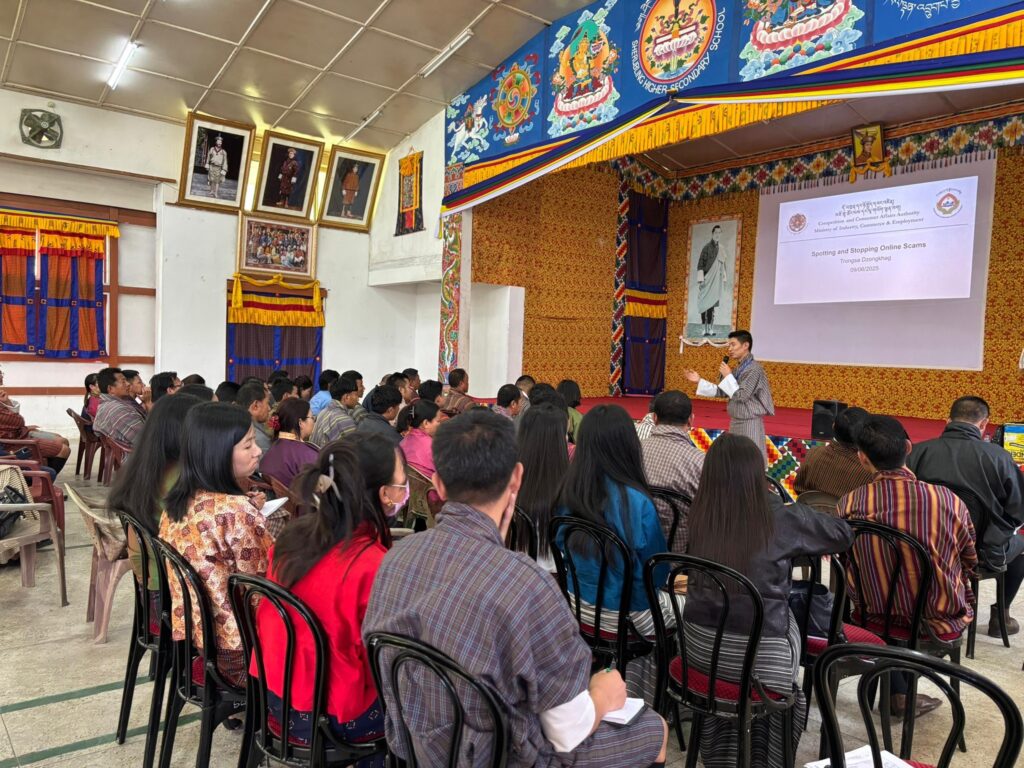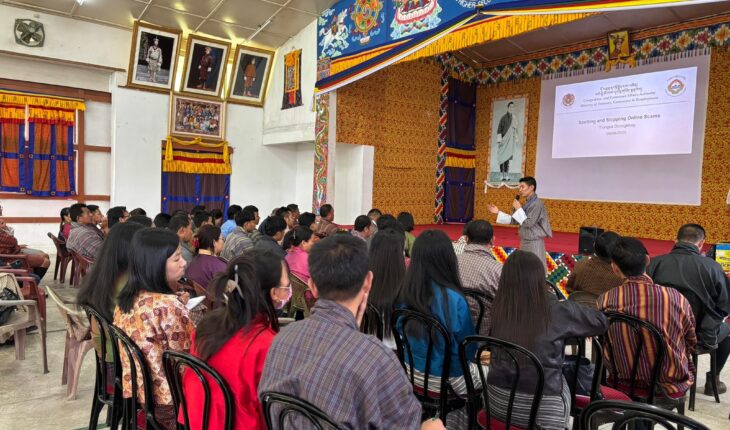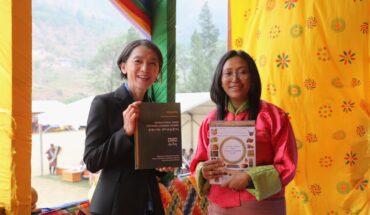
DAWA ZANGMO
Thimphu
comprehensive new study has shed light on the effectiveness of Bhutan’s consumer advocacy programs, revealing significant strides in educating students on consumer rights and responsibilities, while also highlighting persistent awareness gaps among monks and farmers. Conducted by the Competition and Consumer Affairs Authority (CCAA), the research underscores both the achievements and limitations of current outreach efforts, prompting calls for more customized and inclusive strategies to empower vulnerable consumer groups across the country.
Titled “Study on the Effectiveness of Advocacy Programs in Enhancing Consumer Awareness among Students, Monks, and Farmers,” the research was led by Gopal Pradhan, Chief Program Officer, and Neten Wangchuk, Assistant Program Officer with the CCAA’s Consumer Empowerment & Economics Division. The study aims to evaluate how well the CCAA’s consumer protection programs are translating into actual knowledge retention and informed consumer behavior, particularly among those most likely to face challenges in navigating Bhutan’s evolving market landscape.
With Bhutan’s marketplace becoming increasingly diverse and complex featuring a growing presence of online shopping, digital transactions, and imported goods consumer awareness is not just a matter of economic literacy but a safeguard against exploitation. In this context, the CCAA has been proactively conducting advocacy campaigns to educate citizens about their rights, responsibilities, redress mechanisms, and potential online frauds.
Using a variety of media such as info graphics, social media, video content, and in person outreach, the programs particularly target groups considered more vulnerable to unfair trade practices due to limited education, digital literacy, or exposure to modern consumerism. These include students, monks and nuns, and farmers.
“We are not always informed about our rights as consumers. The programs do not reach us often, and even when they do, it’s hard to understand all the technical terms,” said by Tshering from Farmer of Samdrup Jongkhar. “It would help if the gewog officials or chiwog tshogpas held regular sessions on consumer rights. That way, we could ask questions in our own language,” she added.
With more than Nu 0.9 million allocated annually for advocacy efforts, the need to assess their real-world impact has become increasingly urgent. The CCAA’s latest study provides a data-driven answer.
The research followed a quantitative approach using a cross-sectional survey design. From a total of 3,554 individuals who participated in advocacy programs over the past year 1,781 students, 401 monks, and 1,372 farmers a random sample of 166 participants was selected. This included 78 Class XII students aged 17 to 18, 20 monks, and 68 farmers.
Participants were administered a structured questionnaire consisting of 20 multiple choice questions that covered five core thematic areas: consumer rights, responsibilities, recognition of unethical business practices, complaint redress mechanisms, and e-commerce safety. Responses were analyzed to assess knowledge retention in each domain.
The results paint a mixed picture. On the one hand, students demonstrated remarkably high levels of awareness across all categories, while farmers and monks exhibited lower scores, signaling gaps in information absorption and retention.
The study found that 89 per cent of students could correctly identify their consumer rights, including the right to safety, information, choice, and redress. Monks scored 63 per cent and farmers trailed slightly behind at 58 percent. Similarly, for consumer responsibilities such as reading product labels, using goods properly, and reporting complaints students again led with 89 per cent, followed by monks with 67 per cent and farmers with 59 per cent.
These results suggest that while students are effectively absorbing the messages conveyed during advocacy sessions, the same cannot be said for other groups.
Consumer knowledge about unfair trade practices ranging from false advertising to failure in honoring warranties was highest among students, who achieved an impressive 93 per cent accuracy rate. Farmers followed with 64 per cent, and monks scored the lowest at 56 per cent. The overall average across all groups stood at 71 per cent.
“Such unethical practices distort consumer decisions and pose health or safety risks,” noted the focal person. “Recognizing them is a critical first step in self-protection.”
Awareness of how and where to file consumer complaints was another area where students excelled. An overwhelming 99 per cent of student participants knew the proper redress mechanisms, including walk-in complaints, online platforms, toll-free numbers, and regional offices.
However, awareness plummeted among other groups only 56 per cent of monks and 52 per cent of farmers were able to correctly identify redressed options. This disparity is significant given that these mechanisms are essential for holding unethical businesses accountable.
In the era of digital marketplaces and rising cases of online scams, knowledge of e-commerce safety is more vital than ever. Students again topped this category with a 92 per cent correct response rate. Farmers followed at 60 per cent , and monks were the least aware, scoring just 56 per cent.
“Our needs are simple. We don’t buy much, so we haven’t thought deeply about consumer rights. But with more donations and e-commerce items coming in, we are starting to see its importance,’’ said one of the monks of Chokyi Gaytsho Institute in Dewathang.
“We study religious texts, not modern consumer topics. Maybe if the lams or teachers are trained, they can pass on this knowledge during classes,” said by Dechen from Gangtey.
With Bhutan’s digital transition gaining pace, these findings suggest an urgent need for targeted digital literacy programs, particularly for older or more isolated demographics.
The overall average score across all five categories was 70 per cent, indicating that the advocacy programs have achieved a moderate degree of success. Students emerged as the most informed group with an aggregate awareness score of 92.4 per cent. In contrast, monks and farmers scored 59 per cent and 58.6 per cent respectively.
“These figures clearly show that while the advocacy programs are yielding results, the level of knowledge absorption varies significantly by demographic,” the authors observed. “There’s a need for more nuanced approaches tailored to each group’s unique context.”
One contributing factor to the lower scores among farmers and monks may be the lapse of time between program participation and the survey. The study hints at “knowledge decay,” whereby participants forget information due to lack of reinforcement.
In light of the findings, the CCAA study provides a series of recommendations designed to boost the impact of future advocacy efforts, Advocacy content should be adjusted to suit the learning styles and literacy levels of different groups. For instance, using vernacular languages, visual aids, and interactive formats can make information more accessible for monks and farmers.
Refresher sessions every six months could help maintain awareness and counteract knowledge decay. Repetition is especially crucial for individuals who may not engage regularly with formal education or digital content.
Gewog officials, Gups, and local leaders can be engaged as community-level consumer protection ambassadors. This decentralized approach would increase awareness in remote regions where institutional knowledge is weaker.
With scams and fraudulent schemes on the rise, special modules on e-commerce safety should be developed for non-digital consumers. Radio broadcasts, community theater, and mobile outreach teams could be effective mediums for these programs.
If resources permit, annual impact assessments should be institutionalized using pre- and post-surveys to measure program efficacy over time. Students and monks who demonstrate strong awareness could be recruited as peer educators to spread knowledge within their institutions and communities.
The use of videos, dramatizations, and pictorial posters should be expanded, especially in settings where literacy is a barrier. Consumer protection messaging should be woven into broader rural and monastic development initiatives such as agricultural extension services and monastery education programs for better reach and efficiency.
The CCAA’s advocacy programs are evidently playing a key role in equipping Bhutanese consumers with the knowledge necessary to make informed decisions in an increasingly complex market. However, the impact is not uniformly distributed.
While students are clearly benefiting, the findings suggest that farmers and monks remain underserved by the current advocacy model. To close this gap, Bhutan must invest in more inclusive, tailored, and sustained consumer education efforts.
As Bhutan continues its journey toward a digitally enabled and economically vibrant society, ensuring that all citizens regardless of age, occupation, or location are informed and empowered consumers will be critical to achieving equitable growth and market fairness.
The study concludes with a clear call to action with adapt, repeat, and expand. Only then can Bhutan hope to build a truly aware and resilient consumer base.





